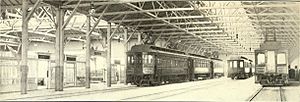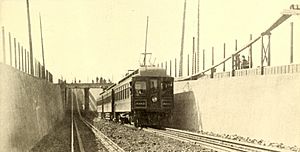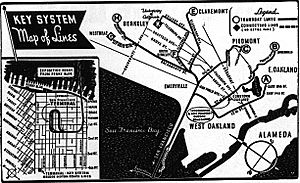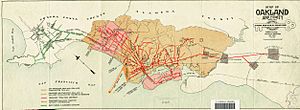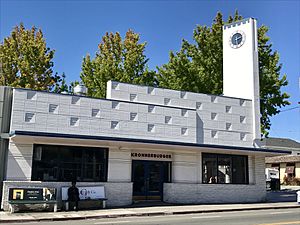Key System facts for kids
Quick facts for kids Key System |
|
|---|---|
 |
|
| Info | |
| Locale | East Bay |
| Transit type | Interurban Streetcar |
| Headquarters | Key System Building 1100 Broadway Oakland, California |
| Operation | |
| Began operation | 1903 |
| Ended operation | (streetcar service) 1948 (commuter train service) 1958 (bus service) 1960 |
| Technical | |
| System length | 66 mi (106 km) |
| Track gauge | 4 ft 8 1⁄2 in (1,435 mm) standard gauge |
| Electrification | Overhead line, 600 V DC Third rail on Bay Bridge |
The Key System was a private company that helped people travel around the East Bay area of San Francisco Bay. It operated from 1903 until 1960. The company ran local streetcars and buses. It also had commuter trains and buses that connected the East Bay to San Francisco.
At first, people traveled between the East Bay and San Francisco using ferries. Later, the Key System trains used the lower deck of the Bay Bridge. At its busiest in the 1940s, the Key System had over 66 miles (106 km) of track. Local streetcar service stopped in 1948. The commuter trains to San Francisco stopped in 1958. Today, the areas once served by the Key System are covered by BART trains and AC Transit buses.
History of the Key System
How the Key System Started
The Key System began by combining several smaller streetcar lines. These lines were put together in the late 1890s and early 1900s. A businessman named Francis Marion "Borax" Smith was behind this effort. He had made a lot of money in the borax mining business.
Smith then became interested in real estate and electric streetcars. He wanted to build new neighborhoods in the East Bay. He also wanted to offer a way for people to travel to San Francisco. The Key System was officially started in 1902. It was first called the San Francisco, Oakland, and San Jose Railway.
Smith bought an old railroad company to use its land and a pier. This pier was a starting point for his own passenger pier. On October 26, 1903, the first trains began carrying passengers. They traveled from downtown Berkeley to the ferry for San Francisco.
Before 1903 ended, Frank C. Havens, a manager, had a clever idea. He designed a map where the train routes looked like an old-fashioned key. The "handle" part covered cities like Berkeley, Piedmont, and Oakland. The "shaft" was the pier, and the "teeth" were the ferry docks. This "key route" idea led to the company being called the "Key System."
Changes and New Owners
Over the years, the company's name changed a few times. In 1908, it became the San Francisco, Oakland & San Jose Consolidated Railway. In 1912, it changed to the San Francisco-Oakland Terminal Railway. Francis Marion Smith left the company in 1913. After facing financial difficulties in 1923, the company was reorganized. It then officially adopted the name Key System Transit Co..
After a big economic downturn in 1929, a new company was created to manage the Key System. In 1938, the name was shortened to just the Key System. During World War II, the Key System also built a special railway. This railway connected Emeryville to the Kaiser Shipyards in Richmond.
In 1946, a company called National City Lines bought most of the Key System. The new owners quickly made many changes. They cut back train routes and increased fares. Many people complained about crowded trains and buses.
There were concerns about how National City Lines operated. They faced legal challenges regarding their business practices. In 1949, National City Lines and other companies were found to have unfairly controlled the sale of buses and related products to the transit companies they owned across the U.S.
In 1948, National City Lines suggested replacing all streetcars with buses. They said this would "modernize" the system. The Oakland City Council and other local cities did not agree. Many citizens also signed petitions against these changes. However, the Public Utilities Commission supported the plan. Traffic planners also thought removing streetcars would help cars move more easily.
The streetcars were replaced by buses in late 1948. Between 1946 and 1954, the cost to ride across the Bay increased. The number of people riding the trains also dropped a lot. The Key System's commuter train service ended in 1958. This happened after many years of fewer people riding the trains and because of the business practices of National City Lines. The last train ran on April 20, 1958. In 1960, a new public agency, AC Transit, took over the Key System's operations.
Most of the old Key System trains and streetcars were scrapped. Some were sold to Buenos Aires, Argentina. A few streetcars and train units were saved. You can see some of them in museums today.
How the Key System Worked
Connecting East Bay to San Francisco
The first way to cross the Bay to San Francisco was by ferryboat. Trains would travel along a long causeway and pier, called a "mole." This mole stretched out from Oakland into the Bay. A fire damaged the pier and a ferryboat in 1933. The pier was rebuilt in a new location.
The Key System ran ferries until January 15, 1939. On that day, a new train track opened on the lower deck of the San Francisco–Oakland Bay Bridge. This allowed Key System trains to go directly to the Transbay Terminal in downtown San Francisco. The bridge railway was shared with other train companies.
Key System Trains and Streetcars
The Key System's first trains were made of wood. They had special devices on their roofs called pantographs. These collected electricity from overhead wires to power the motors. Over time, the trains changed. Newer trains were made of steel and had doors in the middle.
Later, special "bridge units" were designed for the Bay Bridge. These were connected cars that shared a middle wheel set. This design is similar to many modern light rail vehicles. Power was collected from overhead wires, except on the Bay Bridge. There, a "third rail" was used for electricity. The trains ran on 600 volts of direct current.
The outside of the cars was orange and silver. Inside, some seats had woven reed covers, and others had leather. The floors were made of linoleum. During World War II, the roofs were painted gray for camouflage. After National City Lines bought the system, all vehicles were repainted yellow and green.
Transbay Train Routes
Before the Bay Bridge railway, Key commuter trains did not have letter names. They were known by the main street or area they served.
| Line | Name | Notes |
|---|---|---|
| A | Downtown Oakland | Extended to East Oakland in 1941. Later shortened in 1950. |
| B | Lakeshore and Trestle Glen | Originally ran through the Key Route Inn hotel in Oakland. |
| C | Piedmont | Traveled along 40th Street and Piedmont Avenue. Extended in 1924. |
| E | Claremont | Went directly to the Claremont Hotel. |
| F | Berkeley / Adeline Street | Extended on former Southern Pacific tracks through a tunnel. |
| G | Westbrae Shuttle | A streetcar that connected to the H transbay train. Replaced by bus in 1941. |
| H | Monterey Avenue | Also known as the Sacramento Street Line. Replaced by bus in 1941. |
| K | College Avenue | A streetcar that connected to the F transbay train. Used a lot on football game days. Replaced by bus in 1946. |
Line D was planned for Montclair but never built. The Key System also ran special trains to the 1939 Golden Gate International Exposition on Treasure Island. These were called "X" trains. A stop was added at Yerba Buena Island in 1942 for wartime needs.
The A, B, C, E, and F lines were the last Key System rail lines. Train service ended on April 20, 1958. Buses took over these routes, keeping the same letter names. When AC Transit took over in 1960, they continued to use these letter-designated routes. Many of AC Transit's current bus lines still follow these old Key System routes.
Local Streetcar Lines
The Key System's local streetcars were managed by a separate division. It was first called "Oakland Traction Company." Later, it became "East Bay Street Railways, Ltd." and then "East Bay Transit Co." This last name showed that buses were being used more. This division was formed by combining six local streetcar companies in 1898.
The streetcars operated from several large garages called carbarns. These were located in Oakland and Richmond. In the early days, there were also many smaller carbarns. The Key streetcars were first dark green and cream white, then orange. After National City Lines bought the system, they were repainted green and yellow.
The Key System had ordered new electric buses (trolley coaches) in 1945. But the new owners canceled this plan in 1946. The last Key streetcars ran on November 28, 1948. They were then replaced by buses.
Streetcar Line Names
| Line | Name | Notes |
|---|---|---|
| 1 | Oakland–105th Avenue | Line in southern Oakland. |
| 2 | San Pablo | Route shortened in 1933. |
| 3 | Grove | |
| 4 | Shattuck | |
| 5 | Telegraph | An older route. |
| 6 | College | Stopped running in 1946. |
| 7 | Arlington | |
| 8 | Elmhurst | |
| 9 | Stopped running in 1933. | |
| 10 | Piedmont–Hopkins | Called the A line before 1928. |
| 11 | Oakland–38th Avenue | Called the B line before 1928. |
| 12 | Grand | Called the C line before 1928. |
| 14 | East 18th | Called the H line before 1928. |
| 15 | 38th Avenue | Stopped running in 1946. |
| 16 | Leona | Acquired in 1923. Called Line K before 1928. Stopped running in 1936. |
| 18 | Lakeshore-Park Boulevard | Was going to be number 13, but changed to 18. |
| 22 | Fruitvale Avenue | Numbered in 1929. |
| 23 | 23rd Avenue | An older line, numbered in 1929. |
| 24 | Dwight Way | Numbered in 1929. |
| 25 | Park Avenue | Numbered in 1929. |
| 26 | Ninetieth Avenue | Numbered in 1929. |
| 27 | Cemetery | Numbered in 1929. |
| 32 | 40th Street | Numbered in 1929. |
| 33 | Sacramento Street | Numbered in 1929. |
Other Related Rail Systems
The Key System also had a freight business. It was first called Key Terminal Railway. Later, it became the Oakland Terminal Railroad. This company was bought by other railroads and is now the Oakland Terminal Railway.
The East Shore and Suburban Railway was another streetcar system. It ran in Richmond, San Pablo, and El Cerrito. To get to Oakland or San Francisco, people had to transfer to other Key System trains.
The East Bay Electric Lines was another train system. It was run by the Southern Pacific Railroad until 1941. The Sacramento Northern Railroad also used some of the Key System's tracks and pier. It also ran to the Transbay Terminal until 1941.
Key System's Other Properties
From the start, the Key System was planned to help both real estate and transportation. "Borax" Smith and his partner Frank C. Havens created a company called "Realty Syndicate." This company bought large areas of undeveloped land in the East Bay.
The Realty Syndicate also built two big hotels: the Claremont and the Key Route Inn. They also built a popular amusement park in Oakland called Idora Park. Streetcar lines were built to serve all these places. This made the properties more valuable. In its early years, the Key System was actually part of the Realty Syndicate.
Many paths, lanes, and steps in Berkeley were built in new neighborhoods. These allowed people to walk more directly to the new train system. Many of Berkeley's pathways are still used and cared for by local groups today.
What Remains Today
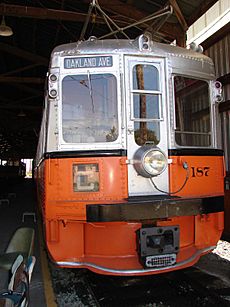
You can still find signs of the Key System today:
- The lower level of the Yerba Buena Tunnel on the Bay Bridge still has "deadman holes." These were small spaces where railway workers could hide when a train came by.
- The eastern end of the San Francisco–Oakland Bay Bridge sits on land that was added to the Key System's old railway path. This path led to the ferry piers.
- The tunnel that Key System trains used to go under other railroad tracks still exists. You can see it near the Target store in Emeryville. This area was once part of the Key System's train yards.
- A road in Albany is named Key Route Boulevard. It was built with a wide middle section for a train line that was never finished.
- The Claremont Hotel, built by a Key System related company, is now the Claremont Resort. It was the end point for the "E" transbay train line.
- The Realty Syndicate Building at 1440 Broadway was built in 1912. It was where "Borax" Smith and Frank C. Havens's company worked. This building is on the National Historic Register.
- The Key System's main office building at 1100 Broadway in Oakland is also on the National Register of Historic Places.
- A building at 41st Street and Piedmont Avenue in Oakland used to be a covered train stop for the C-line. It is now a restaurant. You can see old photos of the Key System on its walls.
- The old Key System Piedmont shops building is now a Whole Foods Market store. This building was originally a powerhouse and car barn.
- The bus yards of today's AC Transit in Emeryville and Richmond were originally Key System bus yards. The Richmond yard was also a streetcar garage.
- Several old Key System streetcars and bridge trains are saved in museums. You can see them at the Western Railway Museum in Solano County. There is also one at the Southern California Railway Museum and another at Seashore Trolley Museum.
- One of the small steam locomotives used by the Key System is on display at the Redwood Valley Railway.
- The Northbrae Tunnel was used by the Key System from 1942 to 1958. It was later opened for cars in 1962.
- The Interurban Electric Railway Bridge Yard Shop Building was used to maintain Key System electric trains. Today, it is called the Bridge Yard Building and is used for events. A power station there also provided electricity for the trains.
- A walking path between York Drive and Ricardo Avenue is still used. It once led to a stop on the C line.
- Some abandoned tracks on Louise Street and Poplar Street in Oakland were rebuilt in 1958. They were used for freight until 1999.


